The Daytona with the in-house movement Cal. 4130 was introduced at the Basel World Fair in year 2000.
The predecessor was the Daytona with modified Zenith El Primero movt. Cal. 4030 (introduced in 1988). Rolex heavily modified the Zenith E.P. movt., and besides other modifications, Rolex altered the bpH (beats per hour) count from 36,000 to 28,800 (from 5 to 4 Hertz). Only about half of the parts of the original Zenith E.P. movt. were untouched after the modification (source: "Chronos", 4/2000).
Rolex had been working on launching the new in-house movt. LONG before year 2000. Already on October 31th. 1995, a patent with drawings of parts of the movt. construction was applied for (Swiss patent number CH199 5000003077), and on October 29th. 1996, Rolex applied for further patents of the movt. (US patent number 5.793.708). (Source: "Chronos", 4/2000).
Now to the Daytona 116520.
CASE::
The Daytona movt. is held in an Oyster case with Triplock crown and two screw-down chronograph pushers. WR is 100 metres. The screw-down feature of the chronograph button acts as lock nuts to prevent unintentional activation under water.
Here is a pic of the crown and pushers:
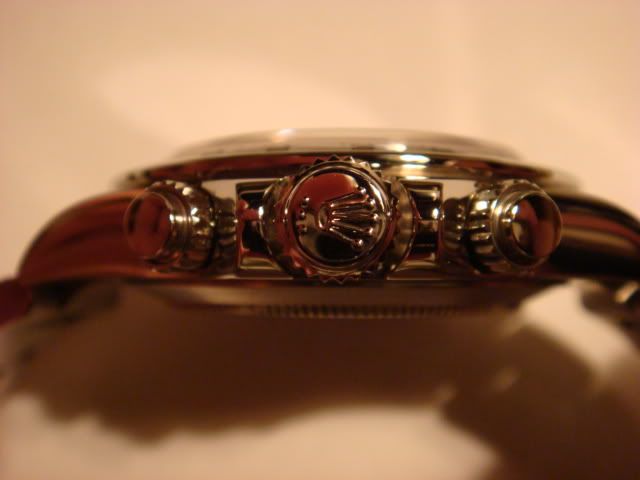
The sapphire crystal stands rather high. A detail that I like since it makes the watch look more "old-fashioned":

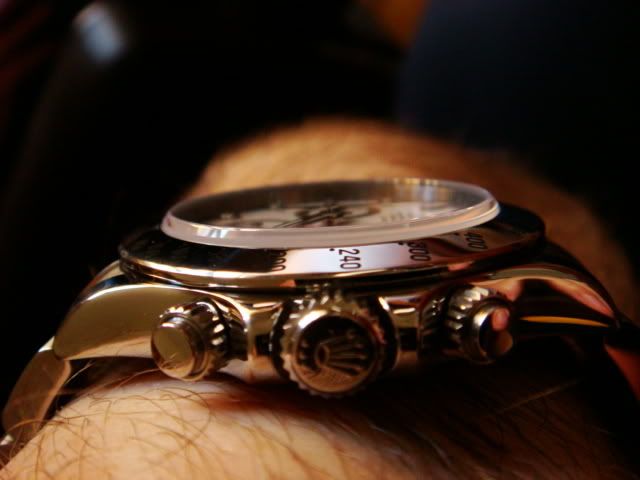
Some interesting details of the chrono pushers are that:
1) the pushers on the predecessor, the "Zenith" Daytona, were not placed at 90 degree angle, but slightly off-angle.
But on the new Daytona, the pushers are placed at a perfect 90 degree angle compared to the case:
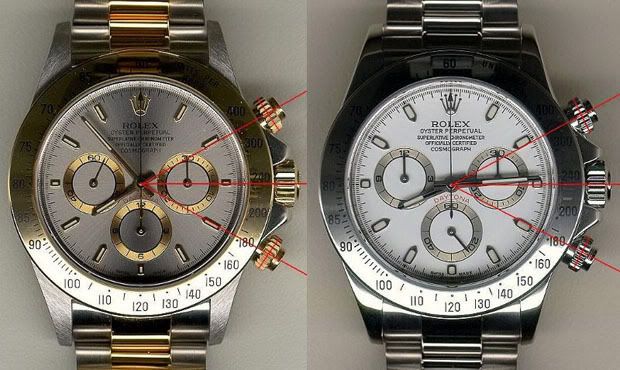
2) the "feel" and sound of the chronograph buttons being activated was in fact perfected by Rolex engineers by simulating the "right" sound and feel via computer aided design programs (source:
Rolex website! Chronograph functions! (CLICK!)
The case also has a fixed "tachymetre" scale (but does not say " tachymetre" but "Units per hour"):
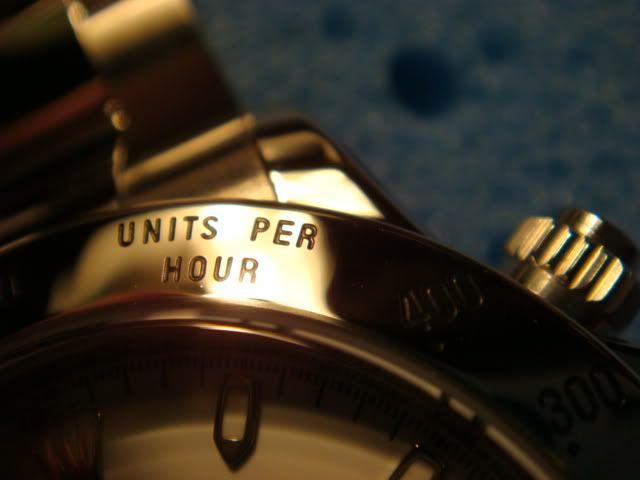
I will turn back to the bezel later under the "Legibility" section.
BRACELET:
The total of links on the new Daytona is 13 (5 on the six side and 8 on the zwelve side).
The bracelet now has SOLID centre links, and the clasp has been improved by introducing a much more solid construction. The clasp has NO "Oyster" pattern as the predecessor Daytona bracelet had, but has an "Easy Link" hidden inside the clasp. The "Easy Link" can be engaged quickly to compensate for a swollen wrist in hot or damp environment:
Clasp, polished centre part, no Oyster bracelet pattern:
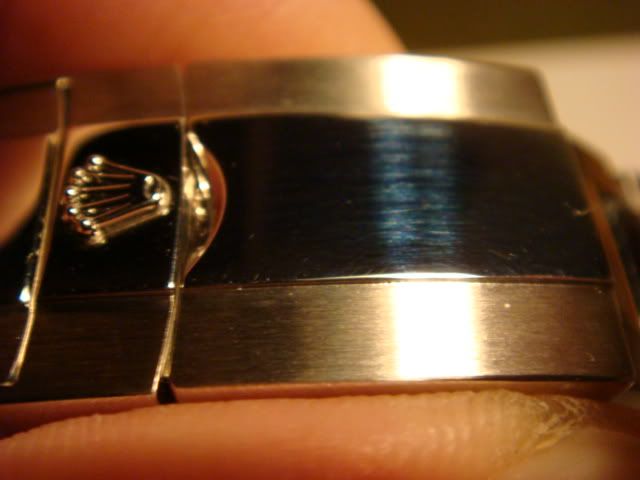
The Fliplock of the bracelet:

The "Easy Link" disengaged (folded in):
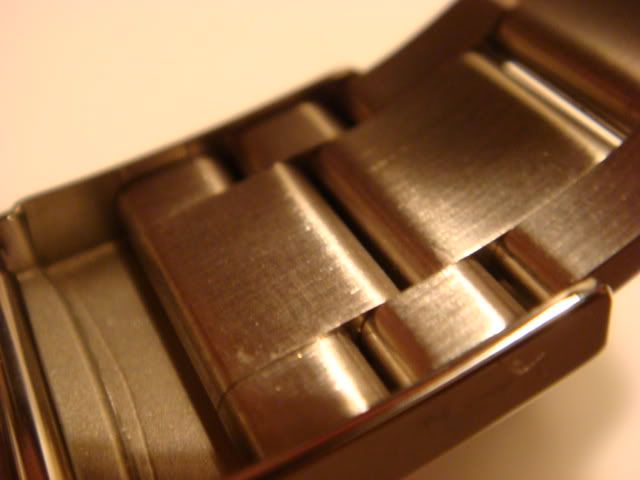
(note how elegantly it is made. You'd not think that there is an "Easy Link"!).
The "Easy Link" engaged (folded out):

(note the pin inside the "Easy Link" that can be moved to one of the three hidden holes to make further clasp adjustments).
There is also a spring loaded pin just under the Fliplock. That pin makes sure that the Fliplock snaps into place perfectly:
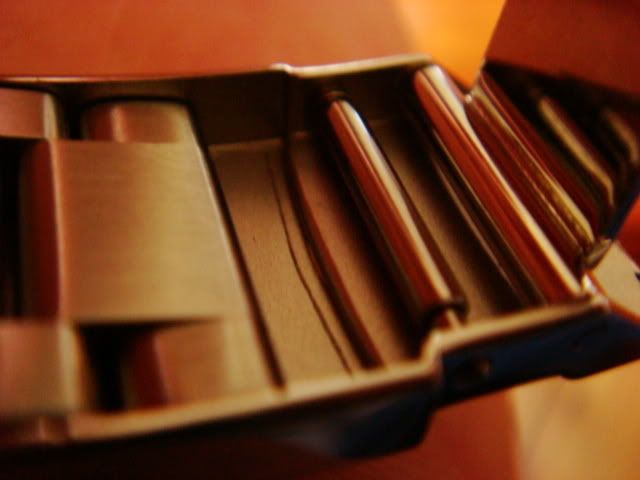
There is ONE disadvantage of the "Easy Link", though:
When you never fold it out, the underside of the clasp scratches the polished centre link that leans against it:
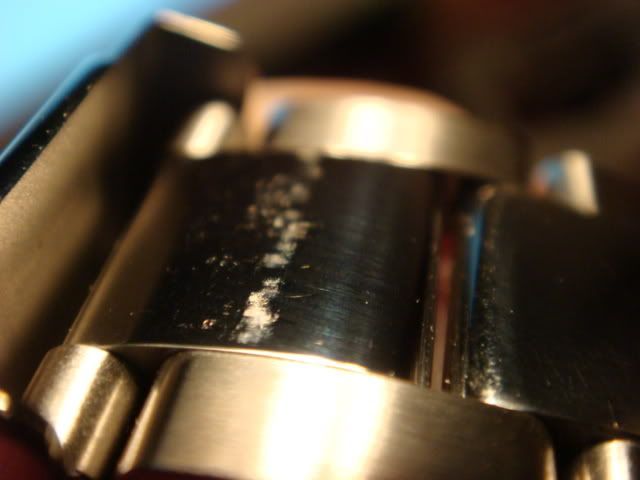
The inside of the clasp caries TWO types of Rolex logos:
The
"RM No. 644" Rolex S.A. (Sociedad Anómina) logo, and the
"RM No. 21424" - "Swirled Rolex" logo:
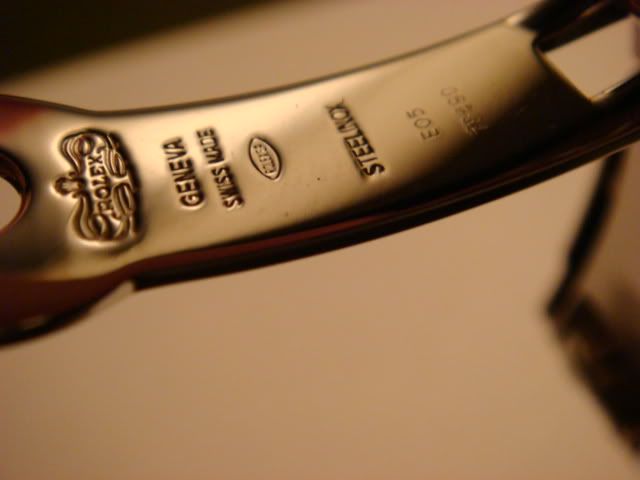
Besides that, the clasp says "Steel Inox" (steel 904L), E05 (date code for clasp. See more about those codes
here! (CLICK!) , "Geneva Swiss Made" and lastly the bracelet ref. No. (78490).
Here is an overview over the Rolex logos used by Rolex:
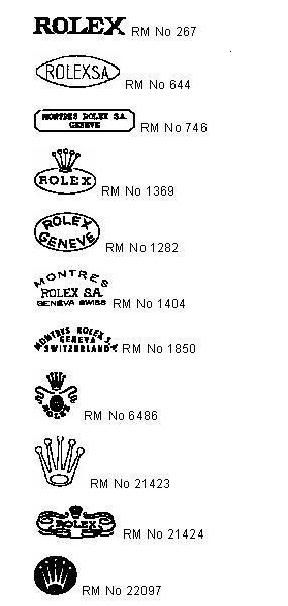 DIAL:
DIAL:
The arrangement of the subsidiary dials of the new Daytona has been changed mainly because of the construction of the new in-house movt. Cal. 4130. The new movement is of the socalled "Hunter" style (continously running second's hand at six o' clock) as compared to the "Lépine" style of the predecessor "Zenith" Daytona that has the continously running second's hand at 9 o' clock (source:
this article! (CLICK!)
So now the subsidiary dials for the chronograph (hours and minutes) are lying on the same axis. Furthermore, the subdials at 9 and 3 were moved up by 7 % compared to the "Zenith" Daytona dial arrangement:

Further changes were bigger indices (hour markers) and - with the late F-series - also the socalled "Fat Hands" instead of "Skinny Hands" that were seen on the "Zenith" Daytona and the first examples of the Daytona with in-house movt. (see more about the difference
here! (CLICK!)
An interesting note:
Chronographs being able to measure time with 1/10 accuracy will have a seconds trail with FIVE small lines between every whole second. The Zenith El Primero with its 36,000 bpH is the only automatic movement that has this chronograph accuracy. Since Rolex tuned the bpH down to 28,800, giving the chronograph an accuracy of 1/8 seconds, actually the seconds trail should have been changed to FOUR small lines between every whole second! But I guess most - even us WIS - can live with that "imperfection".
The chronograph hand is standing EXACTLY at 12 o' clock when reset, very nice! (on the pic the minuterie of 5 can also be seen):
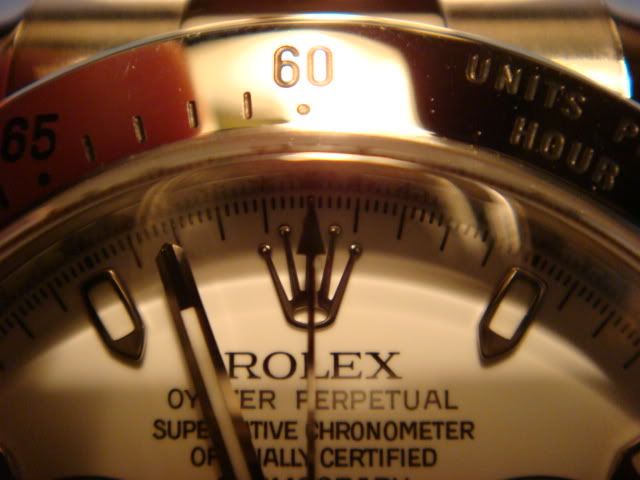
The dial printing (font) is VERY crisp, and the subsidiary dials have a beautiful concentric pattern:

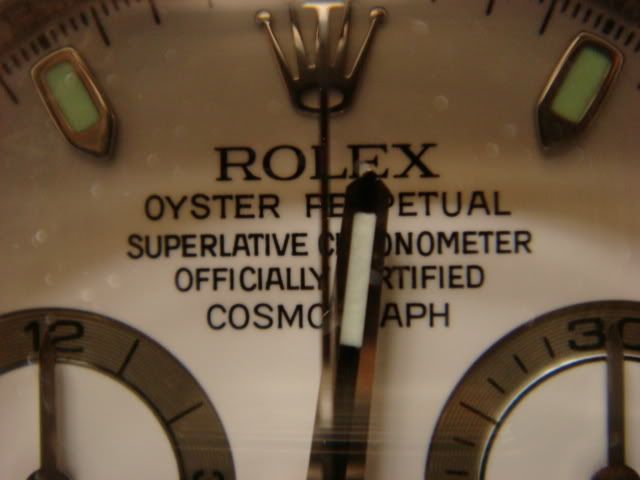 MOVEMENT:
MOVEMENT:
The Cal. 4130 movement has a power reserve of 72 hours when the chronograph is not running and 66 hours when the chronograph is running continously. The "Zenith" Daytona had a power reserve of 54 / 47 hours respectively. Also, the new in-house movts. winds up 68 % faster (by wrist movement on its own) than the "Zenith" Daytona.
The Cal. 4130 now has the Parachrom Blue hairspring that is impervious to the influence of magnetic fields and is also not affected by temperature changes. (read more about the PB hairspring
here! (CLICK!)).
PRECISION:
The new in-house is considered to be among the ten BEST movts. EVER made (source:
this article! (CLICK!), and the main contributor to the amazing precision of the new Daytona movts. is without doubt the Parachrom Bleu hairspring.
My Daytona 116520 went 1 sec. slow, but I had it regulated, and now - 14 days after the regulation - it is still absolutely spot on!
Here is a pic of the Cal. 4130 movt.:
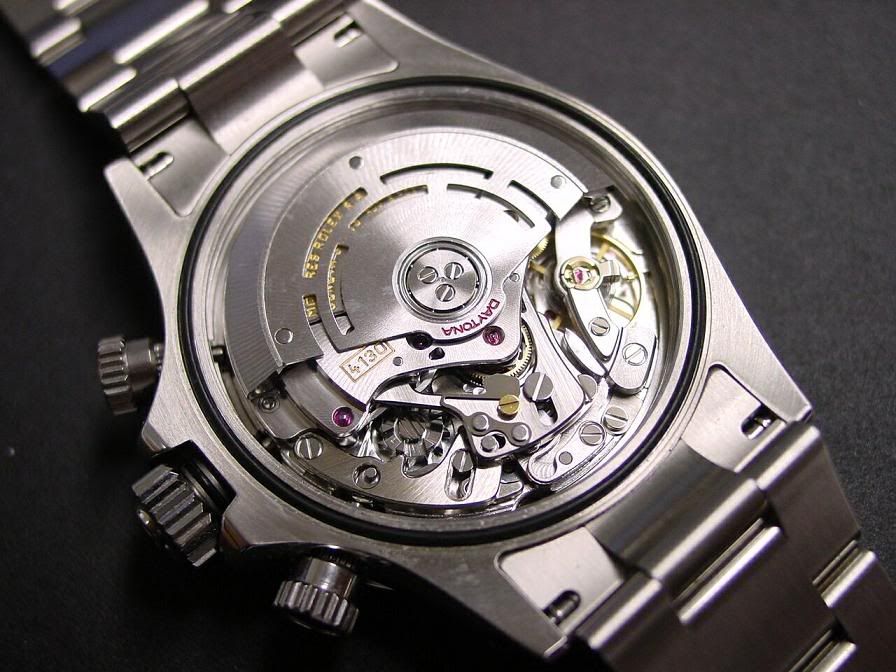
And with almost every part taken out:
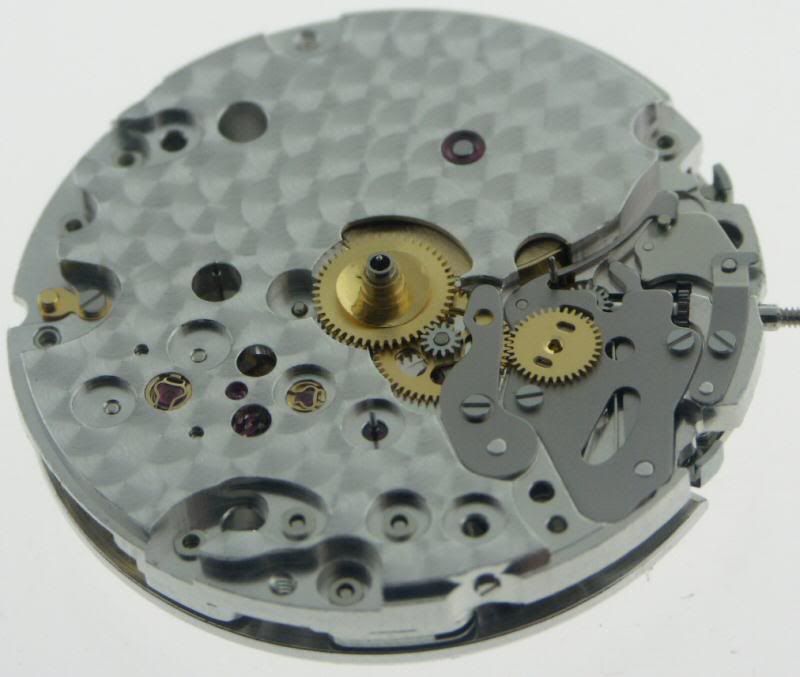 LEGIBILY:
LEGIBILY:
Due to the "Fat Hands" and larger hour markers, the new Daytona is VERY easy to tell the time from. Also, the more logical arrangement of the subsidiary dials of the chronograph is a big help when telling the time.
Furthermore, the lume is very good (and lasts a whole night long when well "charged"):

The BEZEL, however, is very shiny and makes the engraved numbers hard to see:

There are further advantages of the new in-house Cal. 4130 movts. compared to the "Zenith" Daytona movt. To name a few:
1) Easier to service due to the construction where the chronograph area and the winding area are each under its own bridge.
2) Increased power reserve and better balance construction.
3) "Hacking" seconds feature (i.e. you can halt the second's hands by pulling out the winding crown to its last position to synchronise with another time source. You could not halt the continously running second's hand on the "Zenith" Daytona movt.
4) More solid construction of the clasp and bracelet.
Now - after having typed all this - I need a Dry Martini Cocktail!
Cheers, guys and gals!

